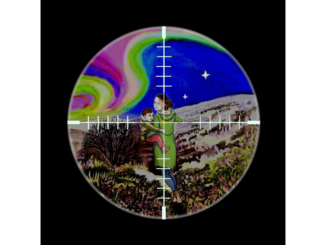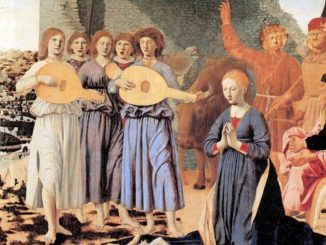
Giovanni Battista Lucini, Public domain, via Wikimedia Commons
In the church year St Stephen’s Day is traditionally the one after Christmas Day, or two days after in some places. In the Eastern church countries which still use the Julian calendar both it and Christmas Day are later – in early January. In many countries it’s a public holiday and in the UK (not the pagans in Scotland though!) where it’s more commonly called Boxing Day (named after the day the Plebs got a box alms from the wealthy).
In past times it use to be an important Christian festival, now sadly secularised and more characterised by unseemly rushes to the shops for reduced price tat, but why, and why was the day after Christmas Day selected as the festival day of St Stephen when we cannot know with certainty the date of his death?.
Who was Stephen?
Stephen was clearly of Greek or Hellenised Jewish descent (large numbers of Jews had adopted Greek culture), one of that large Diaspora of Greeks that settled across and dominated the Successor kingdoms of Alexander the Great as far East as modern Afghanistan and Central Asia, although they were more concentrated in Asia Minor, Syria and the Levant, and Egypt.
His appearance in the history of the Early Christian church is limited to two chapters – 6 & 7 – of the Acts of the Apostles, the doings of the Apostles in the aftermath of the Ascension of Christ, written by the Apostle Luke. Stephen is described as one of the leading ‘Hellenists’ of the first Christians, a faith that from the first attracted many Greeks of non-Jewish background, something that caused some tensions among the latter and the chief among the Hellenised seven Christians charged with spreading the new faith among their linguistic brethren.
Luke describes him “…Stephen, full of grace power, did great wonders and signs among the people…” He was clearly a brilliant debater and bested a series of Jewish priests and scholars, and they, discomforted, charged him with blasphemy and ensured he was put on trial by the Temple hierarchy just as Jesus and St Peter had been previously (Peter was found innocent). Luke recounts Stephen’s self defence at the trial and he pulled no punches,
“You stiff necked people, uncircumcised in heart and ears, who always resist the Holy Spirit. As your fathers did, so you do. Which of the prophets did your fathers not persecute? And they killed those who announced the coming beforehand the coming of the Righteous One, whom you have now betrayed and murdered, you who received the Law as delivered by angels and did not want to keep it.”
Not surprisingly, the accusers went mad, dragged him out of the city and stoned him to death while he followed Jesus in praying for his killers. Thus died the first Christian martyr.
Stephen’s Significance
Stephen’s martyrdom set the pattern for untold millions of subsequent Christian martyrs right up until this very day so it is not surprising that now only was he regarded as a Saint from the early days of the faith as it rapidly spread throughput the Roman Empire, eastwards into Iran and onwards, and south towards Ethiopia and Arabia. A wave of persecutions and executions followed in Judaea, instigated by the Jewish religious authorities such that many Jewish converts had to flee elsewhere, and later by the Roman authorities as it sort to check the wildfire spread of the faith (there are suggestions in some ancient sources that it was making converts in the Imperial household itself before 50 AD).
So Stephen’s martyrdom became the model – paralegal murder with the martyr blessing their killers – for all the others. The expression that arose – “The blood of the martyrs is the seed of the faith” – alludes to the paradoxical nature of martyrdom. Unlike the unconverted Jews, the Christians (far more persecuted) never adopted violent resistance and so never attracted the genocidal response that wiped the Jews out in Judaea by the 130s AD. Jesus’ forbidding of violent resistance was actually based on sound logic. If anything the persecution attracted sympathy from non Christians and eventually the faith had grown peacefully to such as extent that Constantine converted, although his precise reasons are unclear. The Eastern Empire was probably approaching a Christian majority by the time he marched into it to unite the whole Empire under his rule although he had already proclaimed toleration a decade before when he had taken over the less Christian Western Empire.
Stephen & Christian Paradox
We talk about the ‘crown of martyrdom’ and most people will understand that the crown is a reference to the crown of thorns worn by Jesus on the cross, so that paradoxically an instrument of mockery and painful humiliation was transmuted into a symbol of stoic triumph, just as the cross, an instrument of murderous execution, was transformed into a Christian symbol of triumph over death Such paradoxes are at the heart of the Christian faith and indeed the fundamental Christian tenet is a paradox – something that superficially does not seem logical but is true by means of an internal logic (Quantum mechanics is another) – that God came into the world as a humble carpenter’s son and lived in poor obscurity, was brutally executed for offending the hypocritical religious authorities of the day and rose from the dead.
The crown of martyrdom leads to the crowns worn by the saints in Heaven so frequently mentioned in the New Testament, but how many know that stephanos, Stephen’s name, means “crown” in Greek? The stephanos in Greek was a crown, more commonly the laurel wealth worn by winning athletes at the Olympic Games and other events throughout the Greek world. Rulers tended to wear not the stephanos but the diadem, something different – a symbol of their sovereignty and imperial authority. So the first Christian martyr was called ‘Crown’, a not uncommon name at the time or ever since.
So, Stephen’s fate was a paradox and a sign for the future – the first Christian to emulate Christ’s martyrdom. Luke tells us that in his last living moments Stephen shouted how he could see the Gates of Heaven opening for him and Christ awaiting his arrival. Powerful and encouraging imagery for a faith under deadly attack. Everything that followed from his fate, the persecutions from the authorities and the paradoxical peaceful triumph of Christianity over the Roman Empire showed the wise logic of Christ’s injunction not to offer violent resistance. The unconverted Jews who rejected Christ’s teaching tried on three occasions and were exterminated in their homeland and forced to live as exiles for nearly two millennia as a consequence, and the Temple remains to be rebuilt.
But that’s not the only paradox involving this passage about Stephen’s martyrdom. Why is his feast day the day after Christmas (or two days after in some traditions)? Christmas is a joyful day, the birth of a baby after all, so why a day or two later follow it with the gloom of a brutal death?
I have previously written that ancient literature is commonly threaded by pairs of parallel or contrasting events intended by the author to convey a deeper meaning. It can be extremely subtle, both Herodotus and Thucydides used it frequently, as does the Bible, and here is one example linked to another.
The death of the first Christian martyr follows soon after the birth of Christ, joy followed by grief that leads to a paradoxical triumph, so that the Christian festival of Christmas is bittersweet, not mawkish or sentimental (which is how modern secularised Christmas has evolved). It’s also a matching book-end featuring the birth of Christ and the painful birth of the church, and it opens with the matching bittersweet pair of Good Friday and Easter Sunday as the partner book-end. Birth-Death followed by Death-Resurrection – the opening and closing of Jesus’ Earthly life and opening of a new chapter in the faith He founded.
It’s incredibly subtle, but it’s surely there by intention, and it shows how the Apostles saw the dramatic events in which they participated. For them, and for us, it call comes down to those two pairs of two events, it demonstrates the paradoxical nature of the truths of Christianity and Christian teaching and it shines a light on the pressures that helped shaped the early Church and how examples like that of Stephen didn’t discourage the faith’s growth as his executioners intended, but rather fuelled it.
© 1642again 2021


